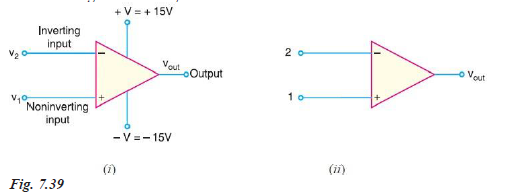- Fig.7.39 (i) shows the schematic symbol of an operational amplifier. The following points are worth noting:
(i) The basic operational amplifier has five terminals: two terminals for supply voltages +V and –V; two input terminals (inverting input and non-inverting input) and one output terminal.( Two other terminals, the offset null terminals, are used to ensure zero output when the two inputs are equal. These are normally used when small d.c. signals are involved.)
(ii) Note that the input terminals are marked + and –. These are not polarity signs. The – sign indicates the inverting input while the + sign indicates the non-inverting input. A signal applied to plus terminal will appear in the same phase at the output as at the input. A signal applied to the minus terminal will be shifted in phase 180° at the output.
(iii) The voltages v
1, v
2 and v
out are node voltages. This means that they are always measured w.r.t. ground. The differential input v
in is the difference of two node voltages v
1 and v
2. We normally do not show the ground in the symbol.

(iv) For the sake of simplicity, + V and – V terminals are often omitted from the symbol as shown in Fig. 7.39(ii). The two input leads are always shown on the symbol regardless of whether they are both used.
(v) In most cases, if only one input is required for an OP-amp circuit, the input not in use will be shown connected to ground. A single-input OP-amp is generally classified as either inverting or non- inverting.
(vi) The OP-amp is produced as an integrated circuit (IC). Because of the complexity of the internal circuitry of an OP-amp, the OP-amp symbol is used exclusively in circuit diagrams.
Wilfykil answered the question on
August 16, 2019 at 07:11